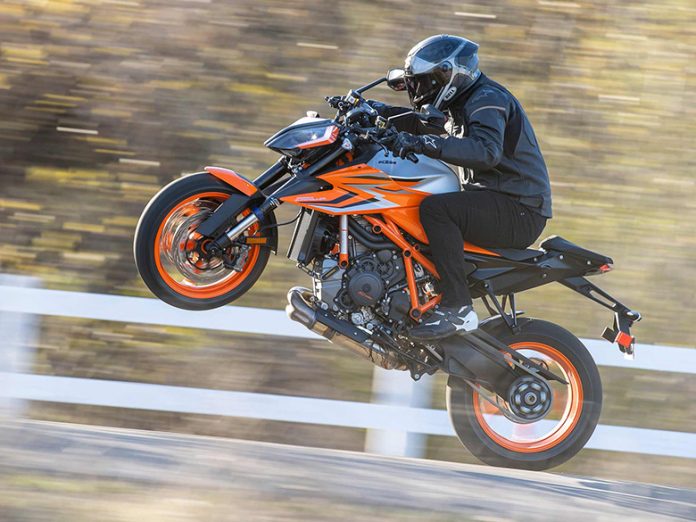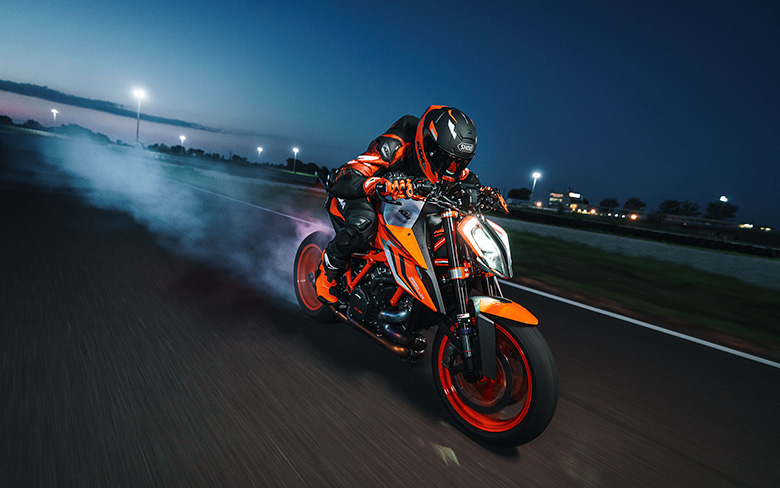We’ve always loved how the European motorcycle industry stands by the unadulterated power of their bikes. As an illustration, consider bikes that have had their fairings removed. What many people have been asking for has finally been delivered by the Europeans: ditch the clip-on and bulky bodywork of a superbike in favor of a more ergonomically sound conventional handlebar, shave a little off the top of the power band, and open it up. The Japanese method produces a balanced motorcycle with safe amounts of power.
2022 KTM 1290 Super Duke R EVO Sports Motorcycle – Features and Specs
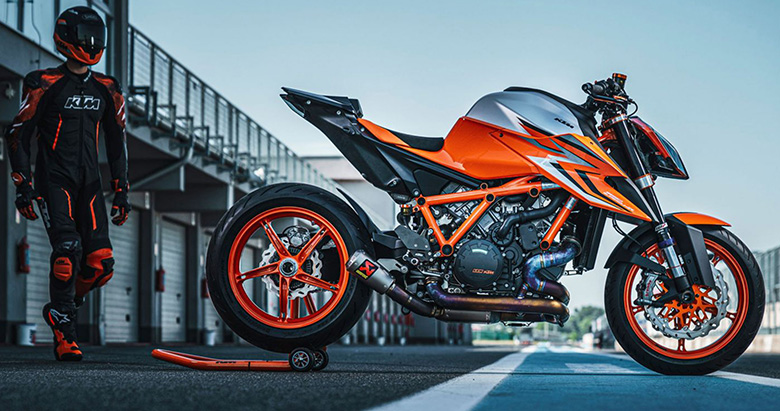
Performance
Most European manufacturers used V-twin engines until around five years ago, but as the performance competition heated up, the twin-cylinder configuration was developed. Almost immediately, we were able to create twins with outputs of more than 150 horsepower, which was a boon for everyone involved. Later, however, most European manufacturers stopped using twin-cylinder engines in their best sports bikes in favor of more cylinders, which allowed for more output.
KTM has been the last holdout with its V-twin engine featured in the 1290 Super Duke R and 1290 Super Adventure ADV models. The newest and most powerful iteration of the LC8 75-degree V-twin engine powers the redesigned 1290 Super Duke R, which saw extensive revisions for 2020. Redesigning about 90% of the bike allowed for a more sophisticated electronics suite and reduced weight, improved handling, or increased power. KTM has dubbed its newest motorbike, which is in its third generation, “The Beast 3.0.” The Austrian V-twin more than lives up to its stellar reputation, with a powerful engine paired with a modern chassis that provides excellent agility and stability at high speeds.
Suspension
Now we’ve arrived at the all-new 1290 Super Duke R Evo, due out in 2022. WP’s new Apex Semi-Active Technology (SAT) suspension enhances the latest 1290 SDR’s monstrous taste. Incorporating a six-axis Bosch IMU and other improved electronics into the WP semi-active suspension for 2020 was a breeze since the IMU helps to determine what damping adjustments to apply to the magnetic valves in the fork and shock. And the electronics package was upgraded to match KTM’s focus on performance. To be fair, our test bike had the $800 Tech Pack added, which includes most of the extras.
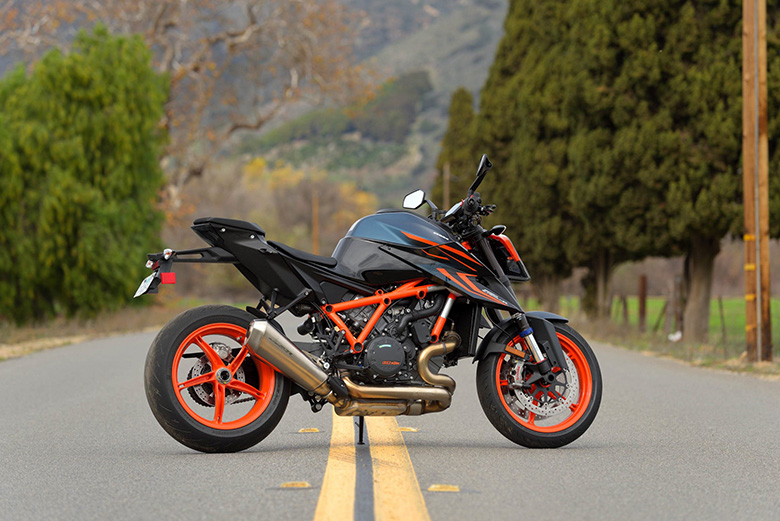
The Suspension Pro menu allows for a wide variety of customization, especially about spring preload. The rider may select between High, Standard, and Low for the SAT system’s automated preload adjustment based on the chassis attitude. As KTM puts it, “a lot of sag on the rear wheel for a low seat height and low riding geometry,” while High and Standard put the chassis in more balanced positions. When you turn it up high, you may ride with greater aggression. Since the 1290 SDR is intended for use on racetracks, its spring rates are somewhat stiff. Even at 160 pounds, the Low auto-preload setting didn’t make the bike seem like a chopper. While I could not ride any courses with a particularly steep chassis pitch that would have shown a difference between the Standard and Low settings, I could conclude that there was none.
Riding Modes
Riders can manually adjust the preload setting in six different percentage increments. To emphasize how firm the spring rates are, I rode mainly with the preload at its minimum, between 0 and 20 percent. The SAT system automatically adjusts the rebound damping to account for the preload, but much more than that and it seems like the rear suspension is sitting too high in its stroke, leading to a rough ride.
You may choose from the regular Sport, Street, and Comfort settings, Auto, which lets the SAT suspension automatically change the damping according to the riding conditions, and Advanced, which allows you manually control the fork and shock damping. When set to sport, the chassis and tires lose their grip. Therefore this mode should be reserved for the track. This street could take the abuse of a canyon race. A person’s back and wrists might still feel larger bumps like frost heaves or sharp bumps even while using the Comfort setting.
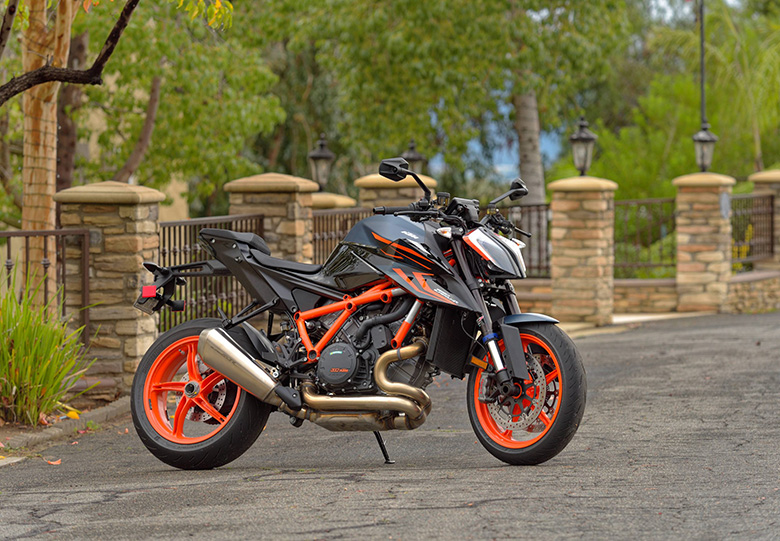
The Auto suspension mode worked effectively in various road and canyon riding scenarios. If you’re trying to trick the SAT system, you can just coast up to a curve and flick the bike into the turn to see the suspension stiffen and the chassis go into cornering mode. The SAT system’s ability to sense when it should tighten the rest and respond quickly is impressive. Unfortunately, we could not fully evaluate the manual suspension damping settings, which do not allow for independent compression and rebound. Honestly, there wasn’t much of a need to mess with the manual settings since the SAT system worked so effectively.
Similar to the 1290 SDR, the SDR Evo has Sport, Street, Rain, Performance, and Track riding modes. The Sport/Street/Rain options include default values for traction control, wheelie control, and throttle responsiveness. Our test bike generated 161 horsepower at 10,100 rpm and 93 pound-feet of torque at 8,300 rpm, with 80 pound-feet of torque happening at 4,200 rpm, so the TC and WC had to step in very often, even in Sport mode, due to the 1290 SDR Evo’s small weight and a short wheelbase. While the operation is straightforward, the power may feel stifled at minor lean angles or for forceful throttle openings in the first three gears. The slight angle may be used as a throttle to increase capacity while lifting the bike.
Technology
Performance and Track riding modes let you fully exploit the 1290 SDR Evo’s engine and chassis. Disabling the wheelie control is an option since it can restrict power when riders need it. Quickly toggle between the nine settings of the traction control system using thumb and forefinger paddles on the left handlebar switchgear, and choose between Streets, Sport, and Track responsiveness settings for the throttle. Since the Track setting may be too harsh for the street in the middle of the throttle turn, most users will prefer the responsiveness of the Sport throttle level with the new quicker-turn throttle of the 1290 SDR Evo (seven degrees less rotation). In Performance ride mode, you’ll have access to all the features of Track mode while still enjoying the convenience of cruise control and Bluetooth connectivity with the My Ride app.
The KTM engine is a regular reminder of how great modern performance V-twins are for everyday street usage. While the competitor with four cylinders may have greater peak power, this advantage is primarily academic in daily driving. Because of its more responsive and manageable ability, the 1290 SDR Evo makes riding at high speeds considerably more straightforward and more fun in the vast majority of situations encountered on shared paved roads. Even at low rates standard in urban traffic, the latest generation of 1290 SDRs has much-improved fueling and throttle responsiveness compared to earlier models. The KTM’s updated chassis provides surprisingly nimble handling and sure-footed stability to counteract the bike’s enormous engine power, making it an unparalleled combination of performance and fun.
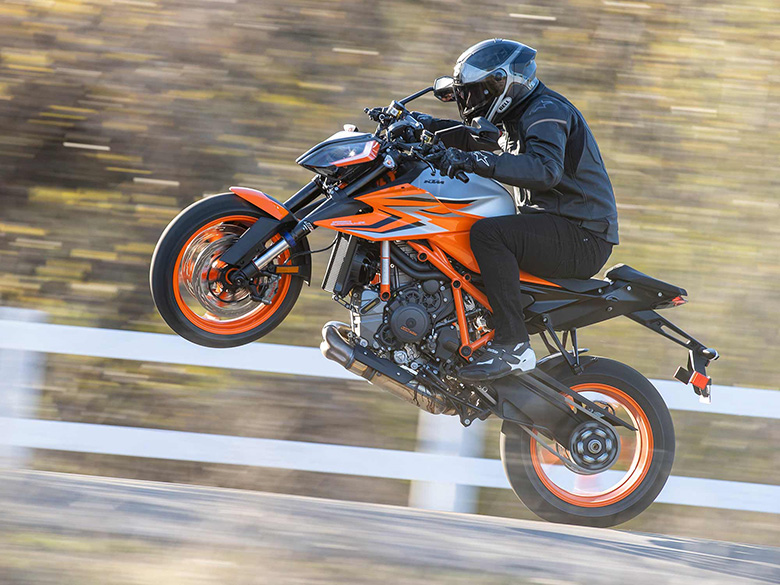
Brakes
The KTM’s stopping power is managed by Brembo’s four-piston Stylema Monoblock calipers biting 320mm discs up front and a twin-piston caliper biting 240mm discs in the back. The front brake is quite responsive to the lever pull, being both sharp and rapid without being too grabby at the outset.
The unusually high ABS threshold is partially attributable to the excellent traction provided by the Bridgestone multi-compound S22 tires, which also interferes when it occurs, quite obviously. Since the Supermoto ABS option seems to have a higher threshold for the front wheel ABS, riders may find that mode to their liking. To increase rear-wheel slippage during turns, this option disables the rear ABS.
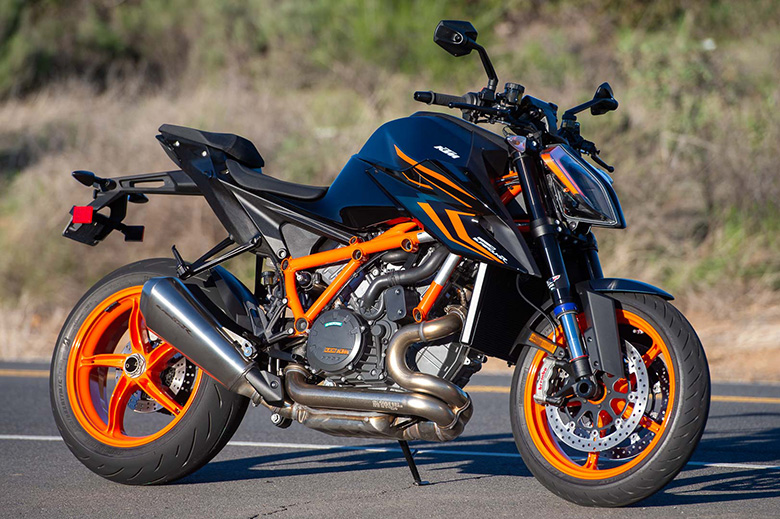
As a tribute to the effectiveness of the front brake, the front fork has an electronic anti-dive system. Even though keeping the front end higher than usual during braking may be helpful for track use, it adversely affects steering into the bend when trail braking. For the duration of the testing, the feature was deactivated and maintained that way.
Dashboard
The KTM is a good time, but it’s not perfect. The owner’s manual doesn’t help much, and the options on the 5-inch TFT display are complicated. For instance, the C1/C2 toggle switch on the left switch gear provides instant access to user-defined functions or menus; however, its customization is not addressed in the user manual. The gearbox is easier to use now that the shift action is crisper and lighter, but reaching neutral at a stoplight is still a chore, and the quick shifter might benefit from better auto-blipping during downshifts.
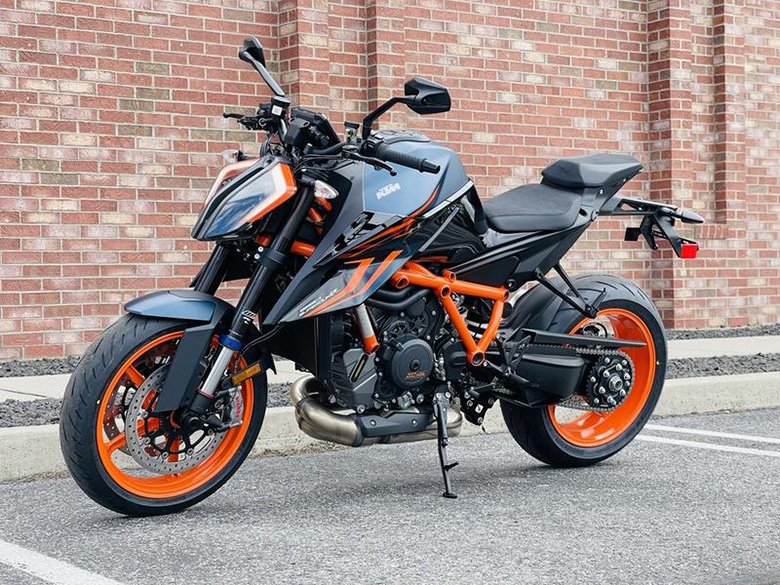
2022 KTM 1290 Super Duke R EVO Sports Motorcycle – Price
Should any of these minor issues deter someone with sufficient financial resources from shelling out $19,599 for a 1290 Super Duke R Evo? There’s just no possibility of that happening. It’s impossible to have a dull time on a KTM Beast 3.1.
2022 KTM 1290 Super Duke R EVO Sports Motorcycle – Technical Specifications
Engine
| Transmission | 6-speed |
| Cooling | Liquid-cooled |
| Power In KW | 132 kW |
| Starter | Electric starter |
| Stroke | 71 mm |
| Bore | 108 mm |
| Clutch | PASC (TM) slipper clutch, hydraulically actuated |
| Displacement | 1301 cm³ |
| EMS | Keihin EMS with RBW and cruise control, double ignition |
| Design | 2-cylinder, 4-stroke, V 75° |
| Lubrication | Forced oil lubrication with three oil pumps |
Chassis
| ABS | Bosch 9.1MP 2.0 (with cornering ABS and SUPERMOTO ABS) |
| Front Brake Disc Diameter | 320 mm |
| Rear Brake Disc Diameter | 240 mm |
| Chain | 525 X-Ring |
| Frame Design | Chrome-moly tubular space frame, powder-coated |
| Front Suspension | WP Semi-active Suspension USD Ø 48 mm (GEN.2) |
| Rear Suspension | WP Semi-active Rear Shock (GEN.2) |
| Steering Head Angle | 64.8 ° |

